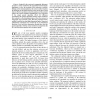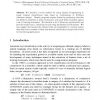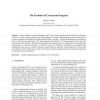229 search results - page 17 / 46 » Potential fitness for genetic programming |
CEC
2010
IEEE
13 years 5 months ago
2010
IEEE
The great majority of genetic programming (GP) algorithms that deal with the classification problem follow a supervised approach, i.e., they consider that all fitness cases availab...
CEC
2008
IEEE
14 years 2 months ago
2008
IEEE
—Inspired by the contours in topography, this paper proposes a contour method for the population-based stochastic algorithms to solve the problems with continuous variables. Rely...
EUROGP
2005
Springer
14 years 1 months ago
2005
Springer
We describe a novel method for using Genetic Programming to create compact classification rules based on combinations of N-Grams (character strings). Genetic programs acquire fitne...
GECCO
2005
Springer
14 years 1 months ago
2005
Springer
We present a molecular computing algorithm for evolving DNA-encoded genetic programs in a test tube. The use of synthetic DNA molecules combined with biochemical techniques for va...
APIN
1998
13 years 7 months ago
1998
Process algebra are formal languages used for the rigorous specification and analysis of concurrent systems. By using a process algebra as the target language of a genetic program...



